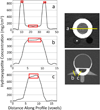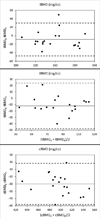Inter-scanner differences in in vivo QCT measurements of the density and strength of the proximal femur remain after correction with anthropomorphic standardization phantoms
- PMID: 25001172
- PMCID: PMC4589175
- DOI: 10.1016/j.medengphy.2014.06.010
Inter-scanner differences in in vivo QCT measurements of the density and strength of the proximal femur remain after correction with anthropomorphic standardization phantoms
Abstract
In multicenter studies and longitudinal studies that use two or more different quantitative computed tomography (QCT) imaging systems, anthropomorphic standardization phantoms (ASPs) are used to correct inter-scanner differences and allow pooling of data. In this study, in vivo imaging of 20 women on two imaging systems was used to evaluate inter-scanner differences in hip integral BMD (iBMD), trabecular BMD (tBMD), cortical BMD (cBMD), femoral neck yield moment (My) and yield force (Fy), and finite-element derived strength of the femur under stance (FEstance) and fall (FEfall) loading. Six different ASPs were used to derive inter-scanner correction equations. Significant (p<0.05) inter-scanner differences were detected in all measurements except My and FEfall, and no ASP-based correction was able to reduce inter-scanner variability to corresponding levels of intra-scanner precision. Inter-scanner variability was considerably higher than intra-scanner precision, even in cases where the mean inter-scanner difference was statistically insignificant. A significant (p<0.01) effect of body size on inter-scanner differences in BMD was detected, demonstrating a need to address the effects of body size on QCT measurements. The results of this study show that significant inter-scanner differences in QCT-based measurements of BMD and bone strength can remain even when using an ASP.
Keywords: Biomechanics; Bone mineral density; Hip; Quantitative computed tomography.
Copyright © 2014 IPEM. All rights reserved.
Conflict of interest statement
None
Figures




Similar articles
-
Novel anthropomorphic hip phantom corrects systemic interscanner differences in proximal femoral vBMD.Phys Med Biol. 2014 Dec 21;59(24):7819-34. doi: 10.1088/0031-9155/59/24/7819. Phys Med Biol. 2014. PMID: 25419618 Free PMC article.
-
QCT of the proximal femur--which parameters should be measured to discriminate hip fracture?Osteoporos Int. 2016 Mar;27(3):1137-1147. doi: 10.1007/s00198-015-3324-6. Epub 2015 Sep 28. Osteoporos Int. 2016. PMID: 26415934
-
Volumetric quantitative computed tomography of the proximal femur: relationships linking geometric and densitometric variables to bone strength. Role for compact bone.Osteoporos Int. 2006;17(6):855-64. doi: 10.1007/s00198-006-0074-5. Epub 2006 Mar 18. Osteoporos Int. 2006. PMID: 16547689
-
Assessment of the strength of proximal femur in vitro: relationship to femoral bone mineral density and femoral geometry.Bone. 1997 Mar;20(3):213-8. doi: 10.1016/s8756-3282(96)00383-3. Bone. 1997. PMID: 9071471
-
Quantitative Computed Tomography (QCT) derived Bone Mineral Density (BMD) in finite element studies: a review of the literature.J Exp Orthop. 2016 Dec;3(1):36. doi: 10.1186/s40634-016-0072-2. Epub 2016 Dec 9. J Exp Orthop. 2016. PMID: 27943224 Free PMC article. Review.
Cited by
-
Effect of different CT scanners and settings on femoral failure loads calculated by finite element models.J Orthop Res. 2018 Mar 6;36(8):2288-95. doi: 10.1002/jor.23890. Online ahead of print. J Orthop Res. 2018. PMID: 29508905 Free PMC article.
-
Effect of CT imaging on the accuracy of the finite element modelling in bone.Eur Radiol Exp. 2020 Sep 1;4(1):51. doi: 10.1186/s41747-020-00180-3. Eur Radiol Exp. 2020. PMID: 32869123 Free PMC article.
-
Using Phantomless QCT for evaluating BMD evolution in maintenance hemodialysis patients.Sci Rep. 2025 Jul 1;15(1):21038. doi: 10.1038/s41598-025-07025-2. Sci Rep. 2025. PMID: 40593118 Free PMC article.
-
Quantification of the difference in hounsfield units of an electron density phantom between a conventional and standing computed tomography machine.Vet Res Commun. 2025 Jun 17;49(4):228. doi: 10.1007/s11259-025-10789-7. Vet Res Commun. 2025. PMID: 40526177 Free PMC article.
-
Novel anthropomorphic hip phantom corrects systemic interscanner differences in proximal femoral vBMD.Phys Med Biol. 2014 Dec 21;59(24):7819-34. doi: 10.1088/0031-9155/59/24/7819. Phys Med Biol. 2014. PMID: 25419618 Free PMC article.
References
-
- Borggrefe J, Graeff C, Nickelsen TN, Marin F, Gluer CC. Quantitative computed tomographic assessment of the effects of 24 months of teriparatide treatment on 3D femoral neck bone distribution, geometry, and bone strength: results from the EUROFORS study. J Bone Miner Res. 2010;25:472–481. - PubMed
-
- Bousson V, Adams J, Engelke K, Aout M, Cohen-Solal M, Bergot C, et al. In vivo discrimination of hip fracture with quantitative computed tomography: Results from the prospective european femur fracture study (EFFECT) J Bone Miner Res. 2010 - PubMed
-
- Carpenter RD, LeBlanc AD, Evans H, Sibonga JD, Lang TF. Long-term changes in the density and structure of the human hip and spine after long-duration spaceflight. Acta Astronautica. 2010;67:71–81.
-
- Engelke K, Fuerst T, Dasic G, Davies RY, Genant HK. Regional distribution of spine and hip QCT BMD responses after one year of once-monthly ibandronate in postmenopausal osteoporosis. Bone. 2010;46:1626–1632. - PubMed
Publication types
MeSH terms
Grants and funding
LinkOut - more resources
Full Text Sources
Other Literature Sources
Medical

